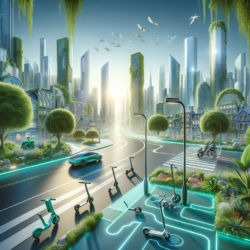
A Techno-Optimist’s Doubt on Earth Day
Many subscribe to a flavor of the techno-optimist belief that, given a real-world problem, humans will invent technology to solve it. But what happens when it’s the technology itself that contributes to the problem? Or, more precisely, the energy required to run all our technology on a global scale. What if our dependence on data and computing power, and its thirst for energy, moves the ball out of reach for a reduction in greenhouse gas emission? These are not questions to be taken lightly, nor a case where it’s advisable to cross one’s fingers and hope for the best.
As it stands, greenhouse gas emissions are only estimated to fall by 2% against 2019 levels by 2030, rather than the aspirational 43%, which was the original target of the Paris Climate Accords, the international treaty to address climate change. Data may now be the world’s most valuable resource, but unlike oil, which serves as a fuel for industries, data centers require a staggering amount of energy to fulfill myriad processing tasks. The International Energy Agency predicts the global consumption of energy by data centers, and the artificial intelligence and cryptocurrency sectors, will require 1,000 terawatt-hours in 2026, which is “roughly equivalent to the electricity consumption of Japan.” Companies, and society at large, will need to grapple with this reality, and strategize how to offset the environmental effects by data centers.
Every month it feels like there’s breaking news about advancements in AI, crypto, cloud computing, metaverse technologies, etc., and we’re not about to put down our smartphones. If anything, we’ll sooner be wearing augmented reality glasses and more closely integrating technology into our everyday lives. Much like drivers now rely on navigation apps for routine car trips to the grocery store, humans will soon wonder how we lived without using smart glasses to identify landmarks or shop without AI search integration.
The past 20 years have seen their fair share of targeted interventions to address energy consumption and demand. The quaint notion that we can recycle our way to a green future has been put to rest. It turns out that only 9% of the global plastic we recycle gets turned into new things, and yet our collective performative theater of carefully washing every yogurt container before it goes into the blue bin persists. On the corporate side, greenwashing has led to the use of creative accounting measures for carbon offsetting, which will be banned in the EU as of 2026 as an environmentally unfriendly practice. And although nuclear fusion has shown real promise, commercial viability is not on the horizon until at least 2030, so the world may want to have a backup plan in place. There is no panacea for limitless energy without environmental consequences.
A positive development has been the evolution of consumer choice to focus on authentically sustainable brands. Brands that focus on the long-term impacts of their products, rather than merely coopting “sustainability” as a marketing tactic. This is an opportunity for brands to tell their story. Companies like Patagonia, who have done the hard work internally and successfully communicated their business practices externally, have been rewarded in the marketplace. Perhaps we’ll soon see cryptocurrencies touting their greener staking approach over energy-hungry miners. Or companies building goodwill for their greening of data centers “towards a sustainable digital transformation.” Those are positive stories waiting to be told to a growing generation of sustainability-minded consumers of technology.
Technology companies often lead by telling their story through a frame of innovation. However, Trilligent has found success working with companies to communicate their commitment to sustainability to consumers. One client we’re proud to represent is ZeBeyond, a software company whose simulation platform helps manufacturers and suppliers make data-driven decisions that reduce R&D time while supporting their sustainability commitments. It is a message that resonates with consumers and potential partners.
It being Earth Day, it would be nice to end this piece with a simple solution. Unfortunately, there isn’t one, but there are sources of inspiration. For all the negative clickbait articles about Gen Z, it’s their prioritization of sustainable consumer practices when making purchases that should be getting more attention. They have also had a positive influence on the purchasing decisions of older generations. This first generation of digital natives have “spent their entire lives in a digital world where technology is second nature and fundamental to their existence.” As such, their environmental frame and consumer priorities may be less a trend and more a way of life in this digital era. We look forward to seeing more companies embrace a sustainability mindset and to working with them to tell their story to a new age of discerning consumers.
RELATED ARTICLES






)